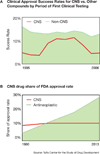Modeling psychiatric disorders for developing effective treatments
- PMID: 26340119
- PMCID: PMC4886231
- DOI: 10.1038/nm.3935
Modeling psychiatric disorders for developing effective treatments
Abstract
Recent advances in identifying risk-associated genes have provided unprecedented opportunities for developing animal models for psychiatric disease research with the goal of attaining translational utility to ultimately develop novel treatments. However, at this early stage, successful translation has yet to be achieved. Here we review recent advances in modeling psychiatric disease, discuss the utility and limitations of animal models, and emphasize the importance of shifting from behavioral analysis to identifying neurophysiological abnormalities, which are likely to be more conserved across species and thus may increase translatability. Looking forward, we envision that preclinical research will align with clinical research to build a common framework of comparable neurobiological abnormalities and to help form subgroups of patients on the basis of similar pathophysiology. Experimental neuroscience can then use animal models to discover mechanisms underlying distinct abnormalities and develop strategies for effective treatments.
Figures



Comment in
-
News Feature: Better models for brain disease.Proc Natl Acad Sci U S A. 2016 May 17;113(20):5461-4. doi: 10.1073/pnas.1605358113. Proc Natl Acad Sci U S A. 2016. PMID: 27190074 Free PMC article. No abstract available.
References
Publication types
MeSH terms
Grants and funding
LinkOut - more resources
Full Text Sources
Other Literature Sources
Medical

